
Apollo Lunar Surface Experiments Package
Encyclopedia
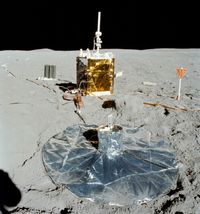
Astronaut
An astronaut or cosmonaut is a person trained by a human spaceflight program to command, pilot, or serve as a crew member of a spacecraft....
s at the landing site of each of the five Apollo missions to land on the Moon following Apollo 11
Apollo 11
In early 1969, Bill Anders accepted a job with the National Space Council effective in August 1969 and announced his retirement as an astronaut. At that point Ken Mattingly was moved from the support crew into parallel training with Anders as backup Command Module Pilot in case Apollo 11 was...
(Apollos 12
Apollo 12
Apollo 12 was the sixth manned flight in the American Apollo program and the second to land on the Moon . It was launched on November 14, 1969 from the Kennedy Space Center, Florida, four months after Apollo 11. Mission commander Charles "Pete" Conrad and Lunar Module Pilot Alan L...
, 14
Apollo 14
Apollo 14 was the eighth manned mission in the American Apollo program, and the third to land on the Moon. It was the last of the "H missions", targeted landings with two-day stays on the Moon with two lunar EVAs, or moonwalks....
, 15
Apollo 15
Apollo 15 was the ninth manned mission in the American Apollo space program, the fourth to land on the Moon and the eighth successful manned mission. It was the first of what were termed "J missions", long duration stays on the Moon with a greater focus on science than had been possible on previous...
, 16
Apollo 16
Young and Duke served as the backup crew for Apollo 13; Mattingly was slated to be the Apollo 13 command module pilot until being pulled from the mission due to his exposure to rubella through Duke.-Backup crew:...
, and 17
Apollo 17
Apollo 17 was the eleventh and final manned mission in the American Apollo space program. Launched at 12:33 a.m. EST on December 7, 1972, with a three-member crew consisting of Commander Eugene Cernan, Command Module Pilot Ronald Evans, and Lunar Module Pilot Harrison Schmitt, Apollo 17 remains the...
). Apollo 11 left a smaller package called the Early Apollo Scientific Experiments Package, or EASEP.
Background
The instrumentation and experiments that would comprise ALSEP were decided in February 1966. Specifically, the experiments, institutions responsible, and principal investigators and coinvestigators were:- Passive Lunar Seismic Experiment: Massachusetts Institute of TechnologyMassachusetts Institute of TechnologyThe Massachusetts Institute of Technology is a private research university located in Cambridge, Massachusetts. MIT has five schools and one college, containing a total of 32 academic departments, with a strong emphasis on scientific and technological education and research.Founded in 1861 in...
, Frank PressFrank PressFrank Press is an American geophysicist.Born in Brooklyn, New York, Press was science advisor to President Jimmy Carter from1976 to 1980,and president of the U.S. NationalAcademy of Sciences from 1981 to 1993...
; Columbia UniversityColumbia UniversityColumbia University in the City of New York is a private, Ivy League university in Manhattan, New York City. Columbia is the oldest institution of higher learning in the state of New York, the fifth oldest in the United States, and one of the country's nine Colonial Colleges founded before the...
, George Sutton. - Lunar Tri-axis Magnetometer: NASA Ames Research CenterNASA Ames Research CenterThe Ames Research Center , is one of the United States of America's National Aeronautics and Space Administration 10 major field centers.The centre is located in Moffett Field in California's Silicon Valley, near the high-tech companies, entrepreneurial ventures, universities, and other...
, C. P. Sonett; Marshall Space Flight CenterMarshall Space Flight CenterThe George C. Marshall Space Flight Center is the U.S. government's civilian rocketry and spacecraft propulsion research center. The largest center of NASA, MSFC's first mission was developing the Saturn launch vehicles for the Apollo moon program...
, Jerry Modisette. - Medium-Energy Solar WindSolar windThe solar wind is a stream of charged particles ejected from the upper atmosphere of the Sun. It mostly consists of electrons and protons with energies usually between 1.5 and 10 keV. The stream of particles varies in temperature and speed over time...
: Jet Propulsion LaboratoryJet Propulsion LaboratoryJet Propulsion Laboratory is a federally funded research and development center and NASA field center located in the San Gabriel Valley area of Los Angeles County, California, United States. The facility is headquartered in the city of Pasadena on the border of La Cañada Flintridge and Pasadena...
, C. W. Snyder and M. M. Neugebauer. - Suprathermal Ion Detection: Rice UniversityRice UniversityWilliam Marsh Rice University, commonly referred to as Rice University or Rice, is a private research university located on a heavily wooded campus in Houston, Texas, United States...
, J. W. Freeman, Jr.; Marshall Space Flight Center, Curt Michel. - Lunar Heat Flow Management: Columbia University, M. Langseth; Yale UniversityYale UniversityYale University is a private, Ivy League university located in New Haven, Connecticut, United States. Founded in 1701 in the Colony of Connecticut, the university is the third-oldest institution of higher education in the United States...
, S. Clark. - Low-Energy Solar Wind: Rice University, B. J. O'Brien.
- Active Lunar Seismic Experiment: Stanford UniversityStanford UniversityThe Leland Stanford Junior University, commonly referred to as Stanford University or Stanford, is a private research university on an campus located near Palo Alto, California. It is situated in the northwestern Santa Clara Valley on the San Francisco Peninsula, approximately northwest of San...
, R. L. Kovach; United States Geological SurveyUnited States Geological SurveyThe United States Geological Survey is a scientific agency of the United States government. The scientists of the USGS study the landscape of the United States, its natural resources, and the natural hazards that threaten it. The organization has four major science disciplines, concerning biology,...
, J. S. Watkins.
The ALSEP was built and tested by Bendix Aerospace
Bendix Corporation
The Bendix Corporation was an American manufacturing and engineering company which during various times in its 60 year existence made brake systems, aeronautical hydraulics, avionics, aircraft and automobile fuel control systems, radios, televisions and computers, and which licensed its name for...
in Ann Arbor, Michigan
Ann Arbor, Michigan
Ann Arbor is a city in the U.S. state of Michigan and the county seat of Washtenaw County. The 2010 census places the population at 113,934, making it the sixth largest city in Michigan. The Ann Arbor Metropolitan Statistical Area had a population of 344,791 as of 2010...
. The instruments were designed to run autonomously after the astronauts left and to make long term studies of the lunar environment. They were arrayed around a Central Station which supplied power generated by a radioisotope thermoelectric generator
Radioisotope thermoelectric generator
A radioisotope thermoelectric generator is an electrical generator that obtains its power from radioactive decay. In such a device, the heat released by the decay of a suitable radioactive material is converted into electricity by the Seebeck effect using an array of thermocouples.RTGs can be...
(RTG) to run the instruments and communications so data collected by the experiments could be relayed to Earth. Thermal control was achieved by passive elements (insulation, reflectors, thermal coatings) as well as power dissipation resistors and heaters. Data collected from the instruments were converted into a telemetry format and transmitted to Earth.
Deployment
The ALSEP was stored in the LM's Scientific Equipment (SEQ) Bay in two separate subpackages. The base of the first subpackage formed the Central Station while the base of the second subpackage was part of the RTG. A subpallet was also attached to the second subpackage which usually carried one or two of the experiments and the antenna gimbal assembly. On Apollo 12, 13, and 14, the second subpackage also stored the Lunar Hand Tool Carrier (HTC). The exact deployment of experiments differed by mission. The following pictures show a typical procedure from Apollo 12.| Picture | Description |
| Pete Conrad Pete Conrad Charles "Pete" Conrad, Jr. was an American naval officer, astronaut and engineer, and the third person to walk on the Moon during the Apollo 12 mission. He set an eight-day space endurance record along with command pilot Gordon Cooper on the Gemini 5 mission, and commanded the Gemini 11 mission... opens the SEQ bay doors through a system of lanyards and pulleys. |
|
| Alan Bean Alan Bean Alan LaVern Bean is a former NASA astronaut, engineer, and painter. Bean was selected to become an astronaut by NASA in 1963 as part of Astronaut Group 3. He made his first flight into space aboard Apollo 12, the second manned mission to land on the Moon, at the age of thirty-seven years in... removes the second subpackage from the SEQ bay. This was accomplished by using the boom which can be seen extended and a pulley system to set it on the ground. By Apollo 17, astronauts felt that the use of the boom and pulley system complicated the operation. And as such, the entire system was removed for Apollo 17. On Apollo 11, Buzz Aldrin chose not to use the system because of a lack of time. |
|
| The first subpackage, which Conrad had removed from the SEQ bay earlier. | |
| Bean lowers the RTG cask into a position where he can access it. | |
| Bean is beginning to remove the dome off the RTG cask. He is using a specialized tool called the Dome Removal Tool (DRT). Note how he has already prepared the RTG for fueling and has already deployed the HTC. Conrad has already removed the subpallet from the RTG subpackage. | |
| Bean discards the dome with the DRT still attached. Neither had a use afterward. | |
| Bean is attempting to remove the fuel element from the cask using the Fuel Transfer Tool (FTT). Note one of the Universal Hand Tools (UHT) attached to the RTG subpackage. On Apollo 12, the fuel element stuck in the cask because of thermal expansion (Bean could feel the heat through his suit). Conrad pounded the side of the cask with a hammer while Bean successfully worked it loose. He then inserted it into the RTG and discarded the FTT. | |
| Bean attaches the RTG subpackage to the carrybar in preparation for the traverse to the ALSEP deployment site. The carrybar would later be used as the mast for the antenna on the Central Station. | |
| During the traverse to the ALSEP deployment site, Conrad took this picture. His shadow indicates that he is carrying the subpallet with one of the two UHTs. | |
| Bean carries the ALSEP out to the deployment site. | |
| Conrad holds the carrybar in his left hand while he releases the antenna gimbal assembly with a UHT. | |
| This photo shows Jim Lovell Jim Lovell James "Jim" Arthur Lovell, Jr., is a former NASA astronaut and a retired captain in the United States Navy, most famous as the commander of the Apollo 13 mission, which suffered a critical failure en route to the Moon but was brought back safely to Earth by the efforts of the crew and mission... training for Apollo 13. He is currently deploying a mock-up of the Central Station. The Station was spring-loaded. After releasing Boyd bolts, the top of the Station would spring up, deploying it. Note the various locations on top of it which held some of the experiments before deployment. They were also held down with Boyd bolts that were released with a UHT. |
|
Common elements
Each ALSEP station had some common elements.| Name | Diagram | Picture | Description |
| Central Station | 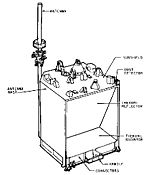 |
The picture shows the Central Station from Apollo 16's ALSEP. The Central Station was essentially the command center for the entire ALSEP station. It received commands from Earth, transmitted data, and distributed power to each experiment. Communications with Earth were achieved through a 58 cm long, 3.8 cm diameter modified axial-helical antenna mounted on top of the Central Station and pointed towards Earth by the astronauts. Transmitters, receivers, data processors and multiplexers were housed within the Central Station. The Central Station was a 25 kg box with a stowed volume of 34,800 cubic cm. In addition, on Apollos 12 to 15, a Dust Detector was mounted on the Central Station which measured the accumulation of Lunar dust. |
|
| Radioisotope Thermoelectric Generator (RTG) | The picture shows the RTG from Apollo 14 with the Central Station in the background. The RTG was the power source for the ALSEP. It utilized the heat from the radioactive decay of plutonium-238 Plutonium-238 -External links:**... and thermocouple Thermocouple A thermocouple is a device consisting of two different conductors that produce a voltage proportional to a temperature difference between either end of the pair of conductors. Thermocouples are a widely used type of temperature sensor for measurement and control and can also be used to convert a... s to generate approximately 70 watt Watt The watt is a derived unit of power in the International System of Units , named after the Scottish engineer James Watt . The unit, defined as one joule per second, measures the rate of energy conversion.-Definition:... s of power. The base of the RTG was the base of the second ALSEP subpackage. |
||
| RTG Cask | The RTG cask stored the plutonium-238 fuel element. It was located to left of the SEQ bay. The cask was designed to withstand a launch vehicle explosion in the event of an abort or a re-entry into Earth's atmosphere (which is what occurred on Apollo 13). The picture shows Edgar Mitchell practicing the removal of the fuel element. | ||
List of experiments
| Name | Diagram | Description |
| Active Seismic Experiment (ASE) | Through the use of seismology Seismology Seismology is the scientific study of earthquakes and the propagation of elastic waves through the Earth or through other planet-like bodies. The field also includes studies of earthquake effects, such as tsunamis as well as diverse seismic sources such as volcanic, tectonic, oceanic,... the internal structure of the Moon could be determined to several hundred feet underground. The ASE consisted of three major components. A set of three geophone Geophone The term geophone derives from the Greek word "geo" meaning "earth" and "phone" meaning "sound".A geophone is a device which converts ground movement into voltage, which may be recorded at a recording station... s was laid out in a line by an astronaut from the Central Station to detect the explosions. A mortar package was designed to lob a set of four explosives from varying distances away from the ALSEP. Finally, an astronaut-activated Thumper was used to detonate one of 22 charges to create a small shock. The diagram shows the Thumper device. |
|
| Charged Particle Lunar Environment Experiment (CPLEE) | The CPLEE was designed to measure the flux Flux In the various subfields of physics, there exist two common usages of the term flux, both with rigorous mathematical frameworks.* In the study of transport phenomena , flux is defined as flow per unit area, where flow is the movement of some quantity per time... es of charged particles such as electron Electron The electron is a subatomic particle with a negative elementary electric charge. It has no known components or substructure; in other words, it is generally thought to be an elementary particle. An electron has a mass that is approximately 1/1836 that of the proton... s and ion Ion An ion is an atom or molecule in which the total number of electrons is not equal to the total number of protons, giving it a net positive or negative electrical charge. The name was given by physicist Michael Faraday for the substances that allow a current to pass between electrodes in a... s. |
|
| Cold Cathode Gauge Experiment (CCGE) |  |
The CCGE was essentially a stand-alone version of the CCIG. |
| Cold Cathode Ion Gauge (CCIG) | The CCIG experiment was designed to measure the pressure of the Lunar atmosphere Atmosphere of the Moon For most practical purposes, the Moon is considered to be surrounded by vacuum. The elevated presence of atomic and molecular particles in its vicinity , referred to as 'lunar atmosphere' for scientific objectives, is negligible in comparison with the gaseous envelope surrounding Earth and most... . It was originally designed to be part of the SIDE, but its strong magnetic field would have caused interference. The CCIG is on the right of the SIDE in the diagram. |
|
| Heat Flow Experiment (HFE) | The HFE was designed to make thermal measurements of the Lunar subsurface in order to determine the rate at which heat flows out of the interior. The measurements could help determine the abundance of radioisotopes and help understand the thermal evolution of the Moon. The HFE consisted of an electronics box and two probes. Each probe was placed in a hole by an astronaut that was drilled to about 2.5 m deep. | |
| Laser Ranging Retroreflector (LRRR) |  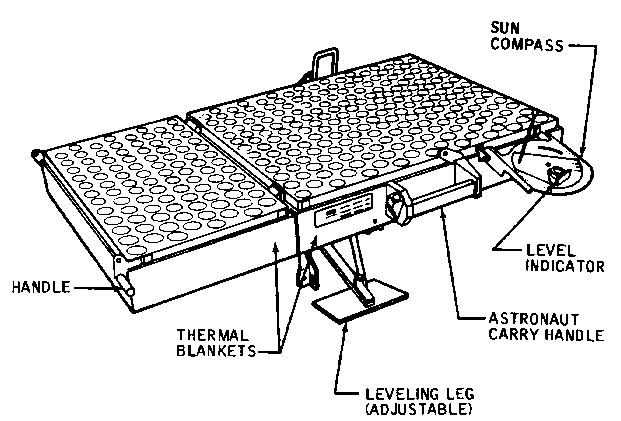 |
By reflecting a laser Laser A laser is a device that emits light through a process of optical amplification based on the stimulated emission of photons. The term "laser" originated as an acronym for Light Amplification by Stimulated Emission of Radiation... shot from Earth off one of LRRRs, the distance to the Moon could be accurately determined. The information could be used to study Lunar recession due to tidal dissipation and the irregular motion of the Earth. The LRRRs are the only experiments still in use today. The above diagram shows the Apollo 11 Apollo 11 In early 1969, Bill Anders accepted a job with the National Space Council effective in August 1969 and announced his retirement as an astronaut. At that point Ken Mattingly was moved from the support crew into parallel training with Anders as backup Command Module Pilot in case Apollo 11 was... version. Apollo 14 Apollo 14 Apollo 14 was the eighth manned mission in the American Apollo program, and the third to land on the Moon. It was the last of the "H missions", targeted landings with two-day stays on the Moon with two lunar EVAs, or moonwalks.... 's was similar to Apollo 11's. The lower diagram shows the larger Apollo 15 version. |
| Lunar Atmosphere Composition Experiment (LACE) | The LACE was designed to detect the composition of the Lunar atmosphere. | |
| Lunar Ejecta and Meteorites Experiment (LEAM) | The LEAM was designed to detect secondary particles that had been ejected by meteorite impacts on the lunar surface and to detect primary micrometeorites themselves. | |
| Lunar Seismic Profiling Experiment (LSPE) | The LSPE was similar to the ASE except the expected depth was to be several kilometers. It consisted of three major components. A set of four geophones was laid out near the ALSEP by an astronaut. The LSPE antenna was used to send signals to the charges. There were eight charges, each consisting of various sizes ranging from 1/8 to 6 lbs. The charges were deployed during the rover Lunar rover The Lunar Roving Vehicle or lunar rover was a battery-powered four-wheeled rover used on the Moon in the last three missions of the American Apollo program during 1971 and 1972... traverses. |
|
| Lunar Surface Gravimeter (LSG) | The LSG was designed to make very accurate measurements of lunar gravity and its change over time. It was hoped the data could be used to prove the existence of gravitational wave Gravitational wave In physics, gravitational waves are theoretical ripples in the curvature of spacetime which propagates as a wave, traveling outward from the source. Predicted to exist by Albert Einstein in 1916 on the basis of his theory of general relativity, gravitational waves theoretically transport energy as... s. |
|
| Lunar Surface Magnetometer (LSM) | The LSM was designed to measure the Lunar magnetic field Magnetic field of the Moon thumb|right|300px|Total magnetic field strength at the surface of the Moon as derived from the Lunar Prospector electron reflectometer experiment.The external magnetic field of the Moon is very weak in comparison to that of the Earth... . The data could be used to determine electrical properties of the subsurface. It was also used to study the interaction of solar plasma and the Lunar surface. |
|
| Passive Seismic Experiment (PSE) | The PSE was designed to detect "moonquakes," either naturally or artificially created, to help study the structure of the subsurface. | |
| Passive Seismic Experiment Package (PSEP) | Similar to the PSE, except it was self-supporting. This meant it carried its own power source (solar arrays Photovoltaics Photovoltaics is a method of generating electrical power by converting solar radiation into direct current electricity using semiconductors that exhibit the photovoltaic effect. Photovoltaic power generation employs solar panels composed of a number of solar cells containing a photovoltaic material... ), electronics, and communications equipment. In addition, the PSEP also carried a Dust Detector. |
|
| Solar Wind Spectrometer Experiment (SWS) | The SWS was designed to study solar wind properties and its effects on the Lunar environment. | |
| Suprathermal Ion Detector Experiment (SIDE) | The SIDE was designed to measure various properties of positive ions in the Lunar environment, provide data on the plasma interaction between solar wind and the Moon, and to determine the electrical potential of the Lunar surface. | |
Apollo 11Apollo 11In early 1969, Bill Anders accepted a job with the National Space Council effective in August 1969 and announced his retirement as an astronaut. At that point Ken Mattingly was moved from the support crew into parallel training with Anders as backup Command Module Pilot in case Apollo 11 was...
(EASEP)
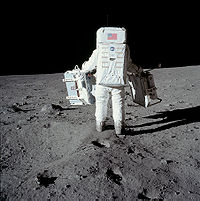
| Name | Picture | Notes |
| LRRR | Notice that the black dust cover has not yet been removed. | |
| PSEP | Failed after 21 days. | |
Apollo 12Apollo 12Apollo 12 was the sixth manned flight in the American Apollo program and the second to land on the Moon . It was launched on November 14, 1969 from the Kennedy Space Center, Florida, four months after Apollo 11. Mission commander Charles "Pete" Conrad and Lunar Module Pilot Alan L...
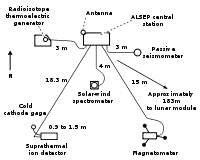
| Name | Picture | Notes |
| LSM | Stored on the first subpackage. | |
| PSE | 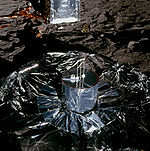 |
Stored on the first subpackage. |
| SWS | Stored on the first subpackage. | |
| SIDE/CCIG | Stored on the second subpackage as part of the subpallet. The CCIG can be seen to the left of the SIDE. The CCIG failed after only 14 hours. |
|
The antenna gimbal assembly was stored on the subpallet. The stool for the PSE, the ALSEP tools, carrybar, and HTC was stored on the second subpackage.
Apollo 13Apollo 13Apollo 13 was the seventh manned mission in the American Apollo space program and the third intended to land on the Moon. The craft was launched on April 11, 1970, at 13:13 CST. The landing was aborted after an oxygen tank exploded two days later, crippling the service module upon which the Command...

S-IVB
The S-IVB was built by the Douglas Aircraft Company and served as the third stage on the Saturn V and second stage on the Saturn IB. It had one J-2 engine...
stage was deliberately crashed on the Moon to provide a signal for the Apollo 12 PSE.
| Name | Notes |
| CPLEE | Stored on the first subpackage. |
| CCGE | Stored on the first subpackage. Only time the CCGE was flown. |
| HFE | Stored on the first subpackage. |
| PSE | Stored on the first subpackage. |
The antenna gimbal assembly was stored on the first subpackage. The stool for the PSE, the ALSEP tools, carrybar, and the Lunar drill was stored on the subpallet. The HTC was stored on the second subpackage.
Apollo 14Apollo 14Apollo 14 was the eighth manned mission in the American Apollo program, and the third to land on the Moon. It was the last of the "H missions", targeted landings with two-day stays on the Moon with two lunar EVAs, or moonwalks....

| Name | Picture | Notes |
| ASE | The above image shows the mortar package. The lower one shows Lunar Module Pilot Edgar Mitchell operating the Thumper. The mortar package, geophones, and Thumper was stored on the first subpackage. Thirteen of the twenty-two Thumper charges were fired successfully. Because of concerns about the deployment of the mortar package, none of the four explosives were fired. There was an attempt to fire them at the end of the ALSEP's operational lifetime, but the charges failed to work after being dormant for so long. |
|
| CPLEE | Stored on the first subpackage. | |
| LRRR | Stored in Quad I of the LM and brought to the ALSEP site separately. | |
| PSE | Stored on the first subpackage. | |
| SIDE/CCIG | Stored on the subpallet. The SIDE is in the upper-left corner while the CCIG is in the center of the picture. |
|
The antenna gimbal assembly was stored on the subpallet. The stool for the PSE, the ALSEP tools, carrybar, and HTC was stored on the second subpackage.
Apollo 15Apollo 15Apollo 15 was the ninth manned mission in the American Apollo space program, the fourth to land on the Moon and the eighth successful manned mission. It was the first of what were termed "J missions", long duration stays on the Moon with a greater focus on science than had been possible on previous...
| Name | Picture | Notes |
| HFE | The center of the picture shows the electronics box and the two wires going to each of the probes. Stored on the second subpackage. During the drilling operations for each of the holes, more resistance was encountered than expected. As a result, the probes could not be inserted to their planned depth. Accurate scientific data could not be obtained from the Apollo 15 experiment until the data could be compared to Apollo 17's. |
|
| LRRR | Stored in Quad III of the LM and brought to the ALSEP site via the Lunar rover. | |
| LSM | Stored on the first subpackage. | |
| PSE | Stored on the first subpackage. | |
| SWS | Stored on the first subpackage. | |
| SIDE/CCIG | The SIDE is on the left while the CCIG is attached on the right. Stored on the subpallet. Note the tilt of the SIDE. This was necessary because of the latitude of Apollo 15's landing site. Also note the boom connecting the SIDE and CCIG. This redesign was done because earlier crews complained about the difficulty to deploy the SIDE/CCIG when only wires connected the two experiments. |
|
The antenna gimbal assembly was stored on the subpallet. The ALSEP tools, carrybar, and stool for the PSE was stored on the second subpackage.
Apollo 16Apollo 16Young and Duke served as the backup crew for Apollo 13; Mattingly was slated to be the Apollo 13 command module pilot until being pulled from the mission due to his exposure to rubella through Duke.-Backup crew:...
| Name | Picture | Notes |
| ASE | The picture shows the mortar package. Note the new base used to improve the experiment after problems were encountered with Apollo 14's. The mortar package, geophones, and Thumper was stored on the first subpackage. The base of the mortar box was stored on the second subpackage. After three of the explosives were fired successfully, the pitch sensor went off scale. It was then decided not to fire the fourth explosive. Nineteen of the Thumper charges were successfully fired. |
|
| HFE | The picture shows the one heat flow probe that was successfully deployed. Stored on the second subpackage. After successfully deploying one of the probes, Commander John Young inadvertently caught his foot on the cable to the experiment from the Central Station. The cable was pulled out of its connector on the Central Station. Although some technicians and astronauts on Earth believed that a repair was feasible, mission control ultimately decided that the time necessary for a repair could be put to better use on other work, and so the experiment was terminated. |
|
| LSM | Stored on the first subpackage. | |
| PSE | Stored on the first subpackage. | |
Apollo 17Apollo 17Apollo 17 was the eleventh and final manned mission in the American Apollo space program. Launched at 12:33 a.m. EST on December 7, 1972, with a three-member crew consisting of Commander Eugene Cernan, Command Module Pilot Ronald Evans, and Lunar Module Pilot Harrison Schmitt, Apollo 17 remains the...
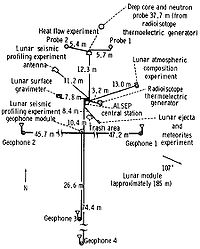
| Name | Picture | Notes |
| HFE | One of the probes can be seen in the foreground while the electronics box and the other probe can be seen in the background. | |
| LACE | ||
| LEAM | The LEAM is in the foreground. The scientific validity of this experiment has been called into question because of some odd data. | |
| LSPE | The upper image shows the antenna for the LSPE in the foreground. The lower image shows one of the charges. | |
| LSG | Because of a design error, the experiment could not accomplish what it was designed for. | |
After Apollo
The ALSEP system and instruments were controlled by commands from Earth. The stations ran from deployment until they were turned off on 30 September 1977 due primarily to budgetary considerations. Additionally, by 1977 the power packs could not run both the transmitter and any other instrument, and the ALSEP control room was needed for the attempt to reactivate SkylabSkylab
Skylab was a space station launched and operated by NASA, the space agency of the United States. Skylab orbited the Earth from 1973 to 1979, and included a workshop, a solar observatory, and other systems. It was launched unmanned by a modified Saturn V rocket, with a mass of...
. ALSEP systems are visible in several images taken by the Lunar Reconnaissance Orbiter
Lunar Reconnaissance Orbiter
The Lunar Precursor Robotic Program is a program of robotic spacecraft missions which NASA will use to prepare for future human spaceflight missions to the Moon. Two LPRP missions, the Lunar Reconnaissance Orbiter and the Lunar Crater Observation and Sensing Satellite , were launched in June 2009...
during its orbits over Apollo landing sites.

